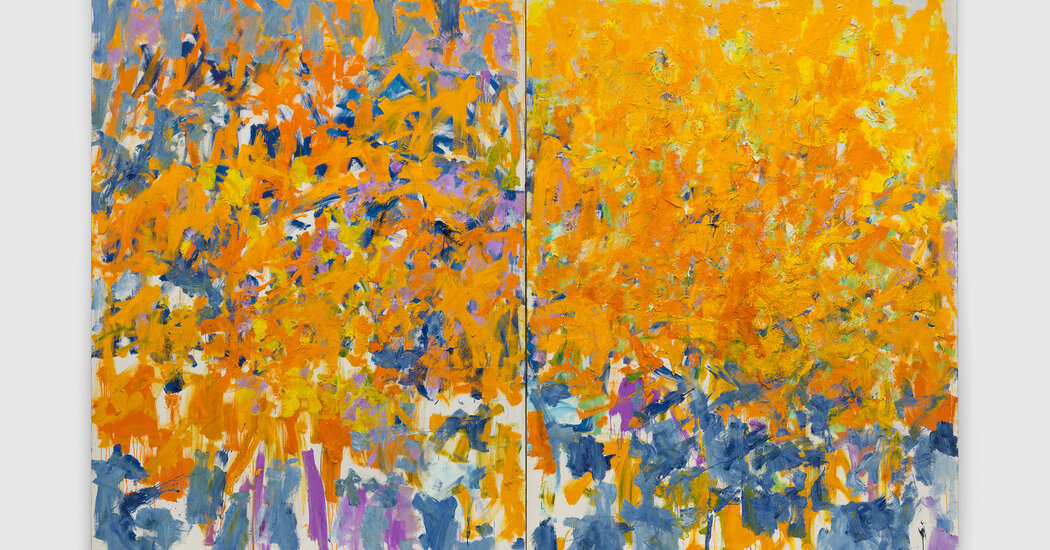
The painter Joan Mitchell, who died in 1992 at the age of 67, saved the best for last. In this regard, she was a lot like Philip Guston, who abandoned Abstract Expressionism for a lush yet acerbic figurative style during the last 13 years of his life. In contrast, Mitchell stayed with Abstract Expressionism, but never stood still. She started young, when she was ambitious but barely any good. Her four-decade career is distinguished by fairly steady forward motion, during which she gave Abstract Expressionism a lyricism, spareness and light that weren’t quite natural to it.
The exuberant selection of late works at David Zwirner in Manhattan traces a short span of this progress. The 18 canvases dating from 1979 to 1985 range in size from substantial (four panels across) to small — amenable to most living-room walls. Almost all are united in color, with blues, greens, yellows and oranges dominating most works. And occasional pinks, as in the opening salvo of “Chez Ma Soeur” (“My Sister’s House”), from 1981, a painting in four panels where the central two blaze with the light of yellow over pink.
In some ways Mitchell might have artistically owed more to France than to New York. She was born in Chicago in 1925 and, after graduating from the School of the Art Institute of Chicago in 1947, spent a year in Paris on a travel grant. She returned to the United States, settling in New York in 1949. There she become more committed to abstraction and quickly gained footing in the downtown New York art world. In 1959 she moved permanently to France, spending a decade in Paris, before heading to the French countryside, like many of the artists she most admired, among them, van Gogh, Matisse, Cezanne and Monet. She bought two acres with a small house in Vétheuil, high above a valley where, beyond fields and woods, she could see the Seine. Just below, was a small shed and tract of land that had once belonged to Monet.
These works show Mitchell gradually embracing a less-is-more approach, pursuing with increasing assurance a simpler, more direct way of painting, often using a wide brush and doing little reworking. This brought larger, more flowing rhythms to her compositions and a more palpable sense of her physical presence.
In “Wood, Wind, No Tuba,” (1979), separate vertical strokes of lavender and blue help cordon off the top and bottom edges of half of the two-panel painting, forming picket fences that hold back the tumult of orange.
Mitchell also became more sensitive to the special gleaming white of bare gessoed canvas. In her earlier paintings, she would try to remove color by painting it over with white, which never looked good. Now she strove to preserve some bare canvas. At a painting’s edges, it might form a kind of haphazard frame of white, clarifying color. Or glimmer through painted areas so they seemed permeable, like screens.
Such glimmers start appearing in the show’s two other large canvases. In “Before, Again I” (1985), a coiled bit of orange does battle with a larger mound of blue-white in a composition that can bring to mind St. George and the Dragon. In “Then, Last Time IV,” also 1985, white encroaches from the edges where another peak of blue-white seems to erupt toward a calligraphic explosion of pure, unmixed forest green in bluntly flat wide strokes. The uninflected flatness of the green echoes in three very small untitled paintings from 1984. Here, quick, firm dashes of blue, sometimes joined by small amounts of other colors look so improvisational you almost expect the paint to be wet. In them, Mitchell seems to be preparing for the next phase of her art.
Joan Mitchell: Paintings, 1979-1985
Through Dec. 17 at David Zwirner, 537 West 20th Street, Manhattan; 212-517-8677, davidzwirner.com.